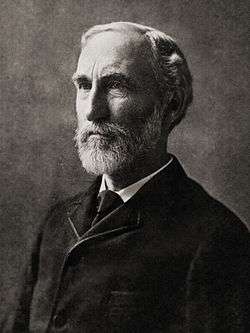Gibbs' inequality

In information theory, Gibbs' inequality is a statement about the mathematical entropy of a discrete probability distribution. Several other bounds on the entropy of probability distributions are derived from Gibbs' inequality, including Fano's inequality. It was first presented by J. Willard Gibbs in the 19th century.
Gibbs' inequality
Suppose that
is a probability distribution. Then for any other probability distribution
the following inequality between positive quantities (since the pi and qi are positive numbers less than one) holds[1]:68
with equality if and only if
for all i. Put in words, the information entropy of a distribution P is less than or equal to its cross entropy with any other distribution Q.
The difference between the two quantities is the Kullback–Leibler divergence or relative entropy, so the inequality can also be written:[2]:34
Note that the use of base-2 logarithms is optional, and allows one to refer to the quantity on each side of the inequality as an "average surprisal" measured in bits.
Proof
For simplicity we prove the statement using the natural logarithm (ln), since
the particular logarithm we choose only scales the relationship.
Let denote the set of all for which pi is non-zero. Then, since for all x > 0, with equality if and only if x=1, we have:
- Then,
The last inequality is a consequence of the pi and qi being part of a probability distribution. Therefore, the sum of all values is unity. Specifically, the sum of all non-zero values is also unity, however, some non-zero qi may be excluded since the choice of indices is conditioned upon the pi. Therefore the sum of the qi may be less than unity.
We now have:
Since the pi and qi are probabilities, their logarithms are negative. The negation of the first sum is thus positive, and the un-negated second sum is negative. We may therefore add the negation of the second sum to both sides (a positive number) without changing the inequality to get:
Since the logarithm of zero is negative infinity, restoring the indices for values of pi that are zero requires some care. We notice that:
The quotient of zeros is an indeterminate form. Typically it is defined to be the convergent of asymptotic values in its neigborhood, or, if such a convergent does not exist, a convention convenient to the case at hand is adopted. In this context, the usual convention is to take the indeterminate form to be identically zero. This gives us:
The right hand side does not grow by our convention, and the left hand side does not grow either because zero times anything is zero, or by convention when qi is also zero.
For equality to hold, we require:
- for all so that the approximation is exact.
- so that equality continues to hold between the third and fourth lines of the proof.
This can happen if and only if
for i = 1, ..., n.
Alternative proofs
The result can alternatively be proved using Jensen's inequality or log sum inequality. Below we give a proof based on Jensen's inequality:
Because log is a concave function, we have that:
Where the first inequality is due to Jensen's inequality, and the last equality is because is a probability distribution.
Further, because is not linear, therefore by the equality condition of Jensen's inequality, we get equality when
Suppose that this ratio is , then we have that
Where we use the fact that are probability distributions. Therefore the equality happens when .
Corollary
The entropy of is bounded by:[1]:68
The proof is trivial – simply set for all i.